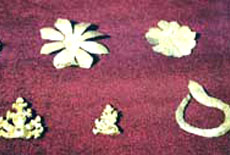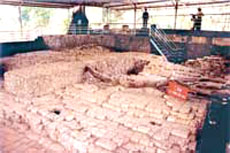They may not be rich but Ta Man and his wife refuse to sell their precious relics from the pre-Christian Oc Eo era to foreign collectors. The treasures belong to the nation, they say.

Watching Ta Man carefully handle his collection of artifacts, one might think he was an archaeologist. But Man and his wife, Cao Xuan Dao, are farmers who share a common passion for collecting antiques from Oc Eo, the site of a busy Funan port between the 1st and 7th centuries, located in what is now An Giang Province in the South.
Oc Eo was considered an economic and cultural centre of the Mekong Delta. With an important position on the Southeast Asian sea routes, it became a meeting place for craftsmen and traders. Archaeologist Louis Malleret of the Ecole Francaise d’Extreme-Orient (EFEO) discovered the site in 1944.
Over 25 years, the couple has amassed the largest private collection of Oc Eo antiques in the country. In his small house, Man has over 100 Oc Eo items made from stone, terra cotta, porcelain, silver, gold and wood, dating from the 7th to the 10th century.
Man, a member of the Vietnam Cultural Heritage Association, lives in Thot Not District in Can Tho City but shuttles between Can Tho, An Giang, Long An and other south-western provinces in his search for Oc Eo antiques to add to his collection.
The beginning"In my childhood, I inherited the passion from my grandfather, who collected old Chinese pottery and porcelain as well as Bat Trang pottery," Man says. "I never get tired of looking at antiques. I have loved them since I don’t know when."
When Man was 15, he lived near a well-known antiquarian. Knowing of his interest, the collector taught his young neighbour everything he knew about the ancient objects, until Man was even able to read the ancient writing inscribed on the antiques. "Collecting Chinese antiques, I think ‘anyway, they belong to a foreign culture’. Meanwhile, Vietnamese ancestors left a precious heritage right here. I live in the Oc Eo cultural zone, why not collect and learn about Oc Eo antiques?" he says. With that thought in mind, Man studied Oc Eo culture in books and from archaeologists. He then began to collect Oc Eo antiques himself.
"In the beginning, I thought Oc Eo was just two simple words and a few belongings. The fact is this is not true," he says. "Whenever I found an object, I tried to learn its story, which made me realise that Oc Eo culture is endless. I won’t be able to understand the whole of the culture even after devoting my entire life to studying it." Man is still hard at work in the field while his wife runs a small shop for trading. They also sell Chinese artifacts, and all profits go towards their passion for collecting Oc Eo antiques.
In 1995, Man bought a limestone statue of the Hari Hara deity from a farmer in Ba The Village; the statue is 1.5 meters high, weighs 90 kilos and dates from the 7th century. Seeing this, villagers brought other antiques to sell Man, but he didn’t buy anything until he saw a beautiful set of stone weapons. He had to sell his entire collection of antique pottery to purchase the set, but it turned out to be worth it; the weapons were later found to pre-date the Christian Era.
Man’s wife, Dao, said that once, when they went searching for antiques, they came across a 200 kg stone statue of a cow that looked incredibly lifelike, which the owner was selling for VND 200 million (USD 12,100). The couple went home to collect the money, but when they returned a few days later they found the statue had been sold to a trader from Thailand.
Later, when his family had business difficulties, Man decided to sell some of his land to maintain his passion for antiques.
Rare and valuable
On a visit to Ba The Village in An Giang Province, Man bought a 1.1 m tall copper Kwan Yin statue, which has one thousand heads and one thousand hands and dates back to the 8th century.
Man said that after buying the limestone statue, his family had a run of good luck in business, so he and his wife decided to give it a place of honour in their home. Once Dao read in a book that whoever finds statues of Oc Eo gods will have good fortune.
"Truthfully, whenever I encounter a challenge I often burn incense and pray in front of the statue of Vishnu. Afterwards I feel peaceful and my difficulties quickly disappear," she says.
Dao believes that fate has guided the couple in their search for Oc Eo antiques. Once, a tourist from Singapore offered him USD 50,000 for the statue. As he has many times before, Man refused.
"We collect Oc Eo antiques with zeal and hope to preserve Oc Eo culture," Man says, "we never sell them to anyone because we’re afraid they might be taken abroad. Oc Eo antiques belong to Vietnam."
The Ba The region still has many antiques which have not yet been excavated, but since they are becoming more and more valuable, it is not easy for collectors like Man to fulfill their desire for these items.
"My husband is interested in weapons, but I’m fond of statues of gods and humans and consider them the height of sculptural art," Dao says.
Ancient Oc Eo culture, which was profoundly influenced by Hinduism, considered Vishnu and his nine other incarnations very important, says Man.
Though Man had very little formal schooling, he has done extensive research, reading books by Dr Le Thi Lien, Prof Phan Huy Le and Prof Luong Ninh, to further his quest for knowledge about the ancient culture and its weapons.
The couple’s only child, Ta Yen Xuan, inherited her parents’ passion for Oc Eo artifacts.
"She’s our happiness. My family shares a common passion," Dao says. "I don’t resemble other mothers. The only legacy I will leave my daughter is the treasure of Oc Eo antiques," she adds.
"Why not a big house or a car? No, because our biggest fortune is Oc Eo antiques, which we have spent our whole lives collecting. My daughter understands. She will continue our work and respect the fruit of our labour."
Deputy Director Nguyen Thi My of the Can Tho City Museum will borrow Man’s antiques for an exhibition in December, 2008.
"Man’s knowledge about Oc Eo culture comes from the documents of famous researchers. He collects antiques, but finds out the history as well," she says. Tran Thanh Tam of Thot Not District’s Cultural Centre has a great deal of respect for Man and Dao’s collection.
"After spending many years collecting antiques, Dao and Man have discovered really valuable and rare items," Tam says, "specialists from the Can Tho Museum, who have seen the collection, praised it as strange and beautiful."
The Oc Eo cultural area is located close to the border between Vietnam, Laos and Cambodia, and the antiques could easily be sold abroad, said Dao.
If Man sells only one item, he would be able to afford a larger house, but he doesn’t consider this an option. Some may say he is nuts, but Man just smiles, "I’m crazy about Oc Eo antiques, I will spend my whole life preserving and collecting them."
"Perhaps 30 years from now, when we can’t travel all over and down dale to find antiques, we will found a small museum displaying our achievement to the public," Man says.